Timely TickSmart™ Tips help keep you safe during tick season. Be sure to check back every time you visit TERC. With ticks in more places than ever before, even one tick is one too many for most people!
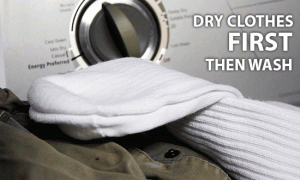 Tip #1: Dry clothes first, then wash
Tip #1: Dry clothes first, then washMost ticks are VERY sensitive to dryness. The very first action to take after working in the yard is to strip clothing off and throw it in the dryer. Blacklegged ticks are most susceptible, while American dog ticks, Lone Star ticks and other Amblyomma species are a bit more robust. To be sure each species achieves fatal crispiness, leave clothes in the dryer on high for 10 minutes.
In our study, gas dryers got hotter than electric dryers, so you might want to add 5 minutes if you own an electric dryer. Believe it or not, ticks were not killed by washing, even in hot water. Clothing just left in the hamper or on the floor may put the next person to touch it at risk. Dry first – then wash.
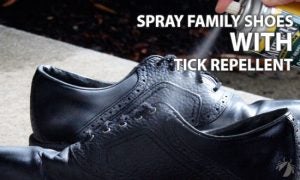 Tip #2: Spray shoes with tick repellent
Tip #2: Spray shoes with tick repellentWhether your family life includes highly active kids playing in your own backyard, regular hiking or camping trips, or family golf outings that include the inevitable slice or hook into the woods; You should spray all your families shoes with tick repellent! Ticks crawl up from the leaf litter, in wooded areas or in your own yard around stonewalls. Spraying shoes with tick repellent is the first line of defense for you and your family and is also the most effective way to kill ticks before they bite.
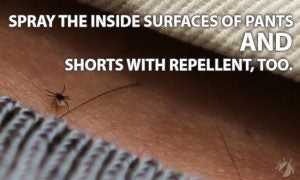 Tip #3: Spray the inside surfaces of pants and shorts with tick repellent
Tip #3: Spray the inside surfaces of pants and shorts with tick repellentTiny ticks crawl up, often UNDER your clothing and not on the outside. That’s why it’s important to spray inside surfaces of pants and shorts with repellent, too. To be effective, the permethrin in tick repellent clothing must contact ticks. While more and more people are heeding our message and relying on tick repellent clothing for tick bite protection, those using sprays to treat their own clothes may not be getting enough active ingredient to where tiny ticks are crawling. When spraying pants and shorts, turn the lower portions (on pants, the bottom 8-10 inches) of the leg INSIDE-OUT and spray there first. Then treat the entire outside surface, too.
Our studies showed that deer ticks only need a brief exposure to properly treated tick repellent clothing (less than 30 seconds) to obtain a lethal dose. But don’t worry, because the margin of safety for humans is ridiculously high. Commercially-treated tick repellent clothes, or those treated using soaking kits, are covered with permethrin inside and out. So, SPRAY CLOTHES INSIDE AND OUT, too.
 Tip #4: Check below the belt for poppy seed-sized or smaller ticks while sitting on the toilet
Tip #4: Check below the belt for poppy seed-sized or smaller ticks while sitting on the toiletDoing DAILY TICK CHECKS is an effective way to prevent disease transmission. But INSPECTING all those places where tiny ticks might crawl is – DIFFICULT! We’ve got sturdy Tick Check cards and a childrens learning kit for knowing where to look and what to look for. We even have an innovative BEST PRACTICE for making daily tick checks as easy as, well, sitting on the toilet! Try it next time; just look down. It’s a lot easier to see many of those “below the belt” places where people commonly find nymphal and larval ticks than while leaning over or contorting to look in the mirror. And most people practice toilet-sitting at least once or twice a day.
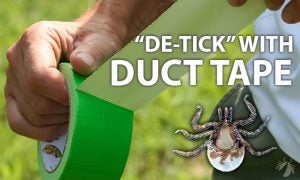 Tip #5: De-tick with duct tape
Tip #5: De-tick with duct tapeTo get the larvae off of you and the dog before they bite, we recommend using sticky duct tape as soon as you notice the ticks latched on. If you don’t find them until they’re already biting, they may not come off as easily, and you may need a fine-pointed tweezer to pluck them off. Remember TickSmart Tip #01: De-ticking clothes is best done by throwing everything into a hot dryer for 10 minutes, even before washing. The ticks will desiccate. Washing clothes first does not kill them but drying does.
 Tip #6: Always have pointy tweezers and a ziplock bag
Tip #6: Always have pointy tweezers and a ziplock bagIf you don’t have one, it’s important to be prepared by having a good pointy tweezers for safe tick removal in your home and car. You might want to try Bug Bite Thing Tick Remover, ProTickMe, or another pointy-tipped tweezer. Both of the ones linked are very reasonably priced. Keep the tweezer in a ziplock bag so you always have something on hand to securely save the tick in when you use the tweezers to remove it.
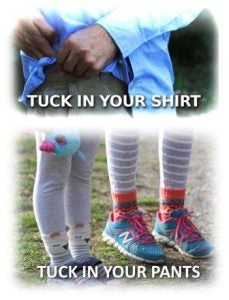 Tip #7: Tuck in your shirt tail when adult ticks are active but tuck your pant cuffs all the time
Tip #7: Tuck in your shirt tail when adult ticks are active but tuck your pant cuffs all the timeDid you know…nymph and adult stage ticks tend to hang out at different heights in the landscape? Nymphs stay close to the ground while adults adventure up just a bit onto vegetation. Because of that, adult ticks typically latch on about knee level as hosts pass by, while nymphs commonly latch on at shoe level. But once on board, ALL ticks tend to crawl upward; so while nymphs crawl upward under untucked pant cuffs and up legs, adult ticks will crawl up the outside of pants, then readily continue to crawl upward under an untucked shirt. It only takes hungry nymph- and adult-stage ticks a few minutes to crawl up your leg or under your shirt (sometimes they wander about for awhile). Once under there, ticks bite wherever clothing or skin folds obstruct their upward movement — for adult ticks, that means especially checking around bra straps, underarms, mid back, and hairline — and it’s really hard to check your back for ticks. For tiny nymphs, lean over…and pay particular attention to ankles, backs-of-knees, groin and waistband (underwear lines). Tucking your pant cuffs and shirt can help keep ticks from getting in and biting!
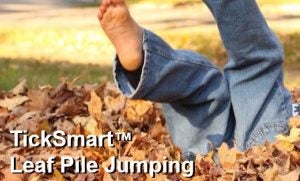 Tip #8: Keep leaf piles for jumping in the middle of the yard
Tip #8: Keep leaf piles for jumping in the middle of the yardKids and dogs seem to just LOVE jumping into freshly raked leaves in the Fall. It’s an adventure full of joy, and you can make it a bit more carefree by piling freshly fallen leaves for jumping into out in the middle of yards. The type of tick most (>80%) people and pets encounter in Fall are adult stage blacklegged ticks. Those ticks are NOT up in trees but ARE hanging from low shrubs and tall grasses on the perimeter of yards and woodland trails. When raking leaf piles for jumping into, don’t use leaves from the yard edges. Instead, leave about a 5 foot leafy border, to be cleaned up and removed with a bit more care. And ALWAYS do a quick tick check once the jumping is over, especially checking the head, hairline, and behind the ears.
 Tip #9: Stay in the middle of trails
Tip #9: Stay in the middle of trails
Humans learn how to walk on their own when they’re about 14 months old but it takes a public health entomologist to offer guidance on how best to walk on a trail to avoid ticks. One way to think about trails is as a pathway–from the safety of the parking lot or open space–heading deeper into tick habitat. Nymph- and larval-stage ticks will more commonly be encountered in the leaf litter that accumulates on the sides of trails than in the middle of the trail; adult-stage ticks are commonly shin-to-knee high on tall grasses and other low vegetation at the trail edge just waiting for a host to pass by. We’re not saying there are no ticks in the middle of trails, just typically far fewer. By hiking in the middle of the path, you’re less likely to get lost, damage plants, cause erosion, run into poison ivy, or pick up ticks.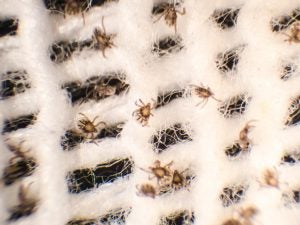 Tip #10: Keep tiny ticks from crawling through your socks
Tip #10: Keep tiny ticks from crawling through your socksAll ticks come in small, medium, and large sizes, and all tick stages have seasons of activity, too. Late July through September is when the youngest and smallest stage of ticks–the larval stage–are most active. Having hatched from eggs laid in clumps of up to 3,000 or more earlier in the springtime, it’s quite common to encounter many larvae all at once, sometimes hundreds of miniscule 6-legged specks that will attach, bite, and suck blood if given the chance. These larvae are mostly at ground level hidden in leaves, so the best first-line defense against this near-invisible invader is to wear permethrin-treated shoes and socks. Spray shoes monthly (May-September; see Tip#2) and consider spraying or purchasing many pairs of socks to be ready for larval ticks–ticks SO SMALL they can crawl right through your socks! Read more about larval tick encounters…
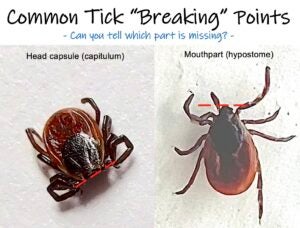 Tip #11: Don’t dread the broken “head” on your tick
Tip #11: Don’t dread the broken “head” on your tickThe second greatest fear people have about tick bites, after contracting Lyme disease, is leaving the tick’s mouth or head in their skin. The 2 most common “breaking points” during tick removal are at the base of the hypostome and the head capsule. Not to worry though. Once either “break” happens, there’s no greater risk for disease transmission just because that part of the tick is still sticking in you. Breaking the tick at either point breaks the connection with the salivary glands, which are back further in the tick’s body and where the germs flow from. Squeezing the back end of the tick during removal is riskier. Check out our tips for safe tick removal http://bit.ly/pointytweezers.
 Consejo #7 Métase la parte inferior de la camisa dentro del pantalón cuando las garrapatas adultas estén activas, pero mantengan los dobladillos de los pantalones todo el tiempo
Consejo #7 Métase la parte inferior de la camisa dentro del pantalón cuando las garrapatas adultas estén activas, pero mantengan los dobladillos de los pantalones todo el tiempo¿Sabía que … las garrapatas en su ciclo ninfa y adulta tienden a pasar el rato en diferentes alturas en el paisaje? Las ninfas permanecen cerca del suelo mientras que los adultos se aventuran un poco hacia la vegetación. Debido a eso, las garrapatas adultas generalmente se enganchan al nivel de la rodilla cuando los huéspedes pasan, mientras que las ninfas comúnmente se enganchan al nivel del zapato. Pero una vez a bordo, TODAS las garrapatas tienden a arrastrarse hacia arriba; así que mientras las ninfas se arrastran hacia arriba, por debajo de los dobladillos de los pantalones y las piernas, las garrapatas adultas se arrastrarán por la parte exterior de los pantalones y luego seguirán arrastrándose hacia arriba por debajo de una camisa desabrochada. A las garrapatas hambrientas en etapa de ninfa y adulta solo les toma unos minutos trepar por su pierna o debajo de su camisa (a veces deambulan por un tiempo). Una vez debajo, las garrapatas muerden donde la ropa o los pliegues de la piel obstruyen su movimiento hacia arriba (para las garrapatas adultas, esto significa especialmente revisar alrededor de los tirantes del sostén, las axilas, la parte media de la espalda y la línea del cabello) y es muy difícil revisar la espalda en busca de garrapatas. Para las ninfas diminutas, inclínate… y presta especial atención a los tobillos, la parte posterior de las rodillas, la ingle y la cintura (líneas de la ropa interior). ¡Metiendo adentro los pliegues de los pantalones y la camisa puedes evitar que las garrapatas entren y te piquen!
 Consejo #9: Manténgase en medio de los senderos
Consejo #9: Manténgase en medio de los senderosLos humanos aprenden a caminar solos cuando tienen alrededor de 14 meses de edad, pero se necesita un entomólogo de salud pública para ofrecer orientación sobre la mejor manera de caminar por un sendero para evitar las garrapatas. Una forma de pensar en los senderos es como una trayectoria, desde la seguridad del estacionamiento o el espacio abierto, que se profundiza más en el hábitat de las garrapatas. Las garrapatas en etapa de ninfa y larva se encuentran más comúnmente en la hojarasca que se acumula a los lados de los senderos que en el centro del camino; Las garrapatas en etapa adulta suelen estar a la altura de las rodillas sobre hierbas altas y otra vegetación baja al borde del sendero, esperando a que pase un huésped. No estamos diciendo que no haya garrapatas en medio de los senderos, solo que suele haber muchas menos. Al caminar en medio del sendero, es menos probable que se pierda, dañes las plantas, provoques erosión, tropieces con hiedra venenosa o cojas garrapatas.
